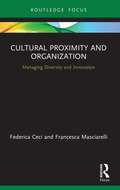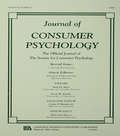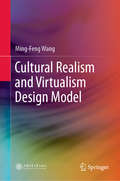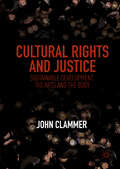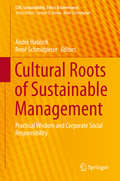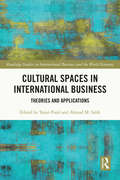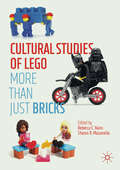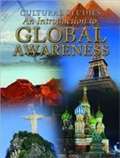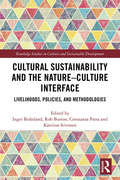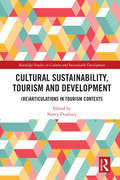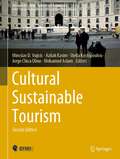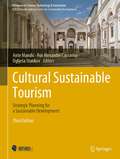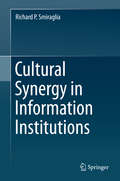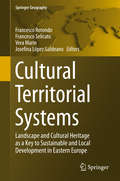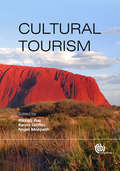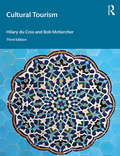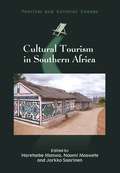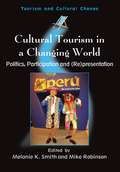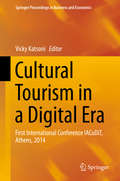- Table View
- List View
Cultural Proximity and Organization: Managing Diversity and Innovation (Routledge Focus on Business and Management)
by Francesca Masciarelli Federica CeciCultural proximity consists in shared language, codes ,and norms of communication and exchange between actors. It is generally considered important for organizations, enhancing communication and facilitation interaction between actors. In such situation, diversity is often seen as a source of richness and originality. However, high levels of proximity might create some risk, leading to lock-in and inertia, with a negative impact on the innovativeness of the organization. While the role of cultural proximity is subject to much debate within organizations studies, a comprehensive understanding of cultural proximity remains elusive. This book explores the organizational implications of the concept of cultural proximity, delving into the managerial challenges posed by diversities and similarities in culture within a business environment using different levels of analysis. The key messages of the present book, grounded on original empirical evidence, can be summarized as follows: cultural proximity is a key factor for managing innovation in present times; innovation requires a deliberate orchestration of the dichotomy between cultural proximity/cultural diversity; there are specific circumstances where proximity can be beneficial for managers and entrepreneurs. The book will be of value to researchers, academics, managers, and students in the fields of management science, human resource management, innovation studies, and organizational studies.
Cultural Psychology: A Special Issue of the journal of Consumer Psychology
by Paul M. Herr Frank R. KardesFirst published in 2000. Routledge is an imprint of Taylor & Francis, an informa company.
Cultural Realism and Virtualism Design Model
by Ming-Feng WangThe book proposes a new Cultural Realism and Virtualism design model for cultural and creative products based on Laozi’s philosophy and analysis of symbolism, metaphysics, three-layered culture, reverse-triangular cultural space and Zen aesthetics. It studies peoples that speak Austronesian languages and offers a detailed comparison of their homogeneous and heterogeneous cultures of color, clothing, housing, boats, birds, symbols, dance and ancestry, and provides insights into the cultural features of deconstruction and construction of color, style, form, shape and function, to compose cultural and creative products using complex, variable, fuzzy evaluation; and structural variation and color evaluation methods. It then uses case studies to show that the products created with the new model not only fulfilled their purpose, but also successfully entered the markets. This book helps qualify decision-making processes, improve accuracy of design scheme evaluation and enhance efficiency in product development, and as such appeals to those in the cultural and creative industry, researchers, designers and those who are interested in product design.
Cultural Revolution and Industrial Organization in China
by Charles BettelheimTranslation of Revolution culturelle et organisation industrielle en Chine.
Cultural Rights and Justice: Sustainable Development, The Arts And The Body
by John ClammerThis book provides an innovative contribution to the emerging field of culture and development through the lens of cultural rights, arguing in favour of a fruitful dialogue between human rights, development studies, critical cultural studies, and concerns about the protection and preservation of cultural diversity. It breaks with established approaches by introducing the themes of aesthetics, embodiment, narrative and peace studies into the field of culture and development, and in doing so, proposes both an expanded conception of cultural rights and a holistic vision of development that not only includes these elements in a central way, but which argues that genuine sustainability must include the cultural dimension, including the notion of cultural justice as recognition, protection and respect extended to the many expressions of human imagination in this world.
Cultural Roots of Sustainable Management: Practical Wisdom and Corporate Social Responsibility (CSR, Sustainability, Ethics & Governance)
by André Habisch René SchmidpeterThisbook provides a multidisciplinary approach to Corporate Social Responsibility. While for decades a purely mathematical-technical orientation dominated thebusiness curriculum, this book presents CSR and sustainability as a businessconcept embedded in its cultural and spiritual context. It initially approachespractical wisdom from different cultural and religious traditions as a source ofspiritual capital for sustainable business practices. Subsequently, it linkscurrent CSR concepts and the latest thinking in CSR with long-standing culturaland spiritual knowledge, promoting a more comprehensive view on sustainabilitymanagement and its implementation at business enterprises. The book collectsand unites viewpoints from various cultural and religious contexts, offering acomprehensive guide for international and globally active companies.
Cultural Spaces in International Business: Theories and Applications (Routledge Studies in International Business and the World Economy)
by Taran PatelCulture studies in international business are passing through difficult times of scrutiny and critique. This is due to the fact that the paradigms, approaches, and methods used so far to study culture have been limited in their scope. For several decades now, approaches that consider national cultures and geo-ethnic origins of interacting individuals have dominated management literature. This book distinguishes itself from other books on Culture in International Business (CIB) studies in two important ways. First, it illustrates how Mary Douglas’s Cultural Theory framework (referred to commonly as DCF) can be used to explore different aspects of international business. This sets the stage for future scholars to consider DCF as an alternative tool of cultural sense making as opposed to limiting themselves to categorical frameworks grounded in static notions of national and/or corporate culture. The second unique feature is that it focuses on the complexities of the applied side of culture (i.e., it takes a culture-in-practice perspective), while simultaneously emphasizing the dynamicity and diversity of culture. The book concludes by offering suggestions for the future of CIB studies. This domain, it predicts, may witness significant changes in the way culture is seen as influencing workplace relations. It also identifies other areas on which CIB scholars may need to focus attention in the future: culture in an increasingly digitalised world, culture and the organisation as a system, and culture and the intelligent/knowledgeable organisation. It will be of interest to researchers, academics, and students in the fields of cross-cultural management, international business, human resource management.
Cultural Studies of LEGO: More Than Just Bricks
by Rebecca C. Hains Sharon R. MazzarellaThis collection examines LEGO from an array of critical and cultural studies approaches, foregrounding the world-renowned brand's ideological power and influence. Given LEGO’s status as the world’s largest toy manufacturer and a transnational multimedia conglomerate, Cultural Studies of Lego: More Than Just Bricks considers LEGO media's cultural messages; creativity with and within LEGO artifacts; and diversity within the franchise, including gender and race representation. The chapters’ in-depth analyses of topics including LEGO films, marketing tactics, play sets, novelizations, and fans offer compelling insights relevant to those interested in the LEGO brand and broader trends in the children’s popular culture market alike.
Cultural Studies: An Introduction To Global Awareness
by Jones Bartlett Publishers StaffIn the global marketplace, we are all interconnected through the Internet, satellites, and commerce. Understanding how to communicate and work with colleagues from across the globe is critical for your studentsrsquo; future success. That understanding begins with Cultural Studies: An Introduction to Global Awareness.This textbook offers students an overview and insights into cultures around the world. Region by region, it explores how history, geography, religion, economics, and politics combine to create unique and diverse cultures. With this greater understanding of how and why cultures work, students will be able to better interpret trends and events abroad.
Cultural Sustainability and Regional Development: Theories and practices of territorialisation (Routledge Studies in Culture and Sustainable Development)
by Joost Dessein Elena Battaglini Lummina HorlingsMeeting the aims of sustainability is becoming increasingly difficult; at the same time, the call for culture is becoming more powerful. This book explores the relationships between culture, sustainability and regional change through the concept of ‘territorialisation’. This new concept describes the dynamics and processes in the context of regional development, driven by collective human agency that stretches beyond localities and marked-off regional boundaries. This book launches the concept of ‘territorialisation’ by exploring how the natural environment and culture are constitutive of each other. This concept allows us to study the characterisation of the natural assets of a place, the means by which the natural environment and culture interact, and how communities assign meaning to local assets, add functions and ascribe rules of how to use space. By highlighting the time-space dimension in the use and consumption of resources, territorialisation helps to frame the concept and grasp the meaning of sustainable regional development. Drawing on an international range of case studies, the book addresses both conceptual issues and practical applications of ‘territorialisation’ in a range of contexts, forms, and scales. The book will be of great interest to researchers and postgraduates in sustainable development, environmental studies, and regional development and planning.
Cultural Sustainability and the Nature-Culture Interface: Livelihoods, Policies, and Methodologies (Routledge Studies in Culture and Sustainable Development)
by Rob Burton Inger Birkeland Constanza Parra Katriina SiivonenAs contemporary socio-ecological challenges such as climate change and biodiversity preservation have become more important, the three pillars concept has increasingly been used in planning and policy circles as a framework for analysis and action. However, the issue of how culture influences sustainability is still an underexplored theme. Understanding how culture can act as a resource to promote sustainability, rather than a barrier, is the key to the development of cultural sustainability. This book explores the interfaces between nature and culture through the perspective of cultural sustainability. A cultural perspective on environmental sustainability enables a renewal of sustainability discourse and practices across rural and urban landscapes, natural and cultural systems, stressing heterogeneity and complexity. The book focuses on the nature-culture interface conceptualised as a place where experiences, practices, policies, ideas and knowledge meet, are negotiated, discussed and resolved. Rather than looking for lost unities, or an imaginary view of harmonious relationships between humans and nature based in the past, it explores cases of interfaces that are context-sensitive and which consciously convey the problems of scale and time. While calling attention to a cultural or ‘culturalised’ view of the sustainability debate, this book questions the radical nature-culture dualism dominating positive modern thinking as well as its underlying view of nature as pre-given and independent from human life.
Cultural Sustainability, Tourism and Development: (Re)articulations in Tourism Contexts (Routledge Studies in Culture and Sustainable Development)
by Nancy DuxburyCultural Sustainability, Tourism and Development considers how tourism provides a lens to examine issues of cultural sustainability and change. It discusses how cultural and natural assets, artistic interventions, place identity, policy strategies, and community well-being are intertwined in (re)articulations of place and local dynamics that occur in tourist locations. With a primary focus on culture in sustainable development, the book clarifies connections between culture as a core dimension of local sustainability and cultural dimensions of sustainable tourism. It highlights the roles and place of cultural expression, artistic activity, and heritage resources in local or regional sustainable development contexts. Chapters critically examine the dimensions of tourism-invoked dynamics of change and the cultural impacts of tourism-related activities. The book concludes with proposals for new culture-informed and creativity-based approaches, mediations, and relations to encourage a better balance between visitors and residents’ quality of life and the broader sustainability of the area. Interdisciplinary and international in scope, contributions reflect on communities and rural areas located in Brazil, Canada, Croatia, India, Italy, Japan, the Netherlands, Poland, Portugal, and the United States. This book will be of great interest to students and scholars of cultural development and policy, heritage studies, cultural tourism and sustainable tourism, cultural geography, and regional development.
Cultural Sustainable Tourism (Advances in Science, Technology & Innovation)
by Azilah Kasim Stella Kostopoulou Mohamed Aslam Miroslav D. Vujicic Jorge Chica OlmoThis book is an assemblage of diverse yet homogenous research papers that bring together the issues and challenges of cultural heritage conservation and tourism sustainability. The richness of this book stems from its inclusion of diverse case studies from around the globe while scrutinizing the cases of both deterioration and sustainability of cultural heritage belonging to different eras.This book sheds light on the connections between culture as an essential dimension of local sustainability and cultural dimensions of sustainable tourism, further contributing to the complex discussion between culture and tourism. This book gives an overview of current research and subjects of discussion that focuses on cultural sustainable tourism through several sections, such as planning and management of sustainable tourism, sustainable cultural tourism development in a digital era, social and economic impacts of cultural tourism, and sustainable tourism development in urban areas
Cultural Sustainable Tourism: Strategic Planning for a Sustainable Development (Advances in Science, Technology & Innovation)
by Uglješa Stankov Ante Mandić Rui Alexandre CastanhoThis book discusses the the integration between tourism and heritage and strategies to achieve sustainability in the tourism sector. The book adds innovative insights into the development of new practices solving challenges of sustainability in this sector and promoting responsible tourism. The book in hands also offers solutions and discusses sustainable tourism environment, social and economic impacts of tourism, and policies and mechanisms for heritage preservation. The primary audience of this book will be scholars, planners, architects, and stakeholders interested in sustainable tourism. This book is a culmination of selected research papers from IEREK’s third edition of the International Conference on Cultural Sustainable Tourism (CST) held online in collaboration with the University of Maya, Portugal (2021).
Cultural Synergy in Information Institutions
by Richard P. SmiragliaCultural forces govern a synergistic relationship among information institutions that shapes their roles collectively and individually. Cultural synergy is the combination of perception- and behavior-shaping knowledge within, between, and among groups. Our hyperlinked era makes information-sharing among institutions critically important for scholarship as well as for the advancement of humankind. Information institutions are those that have, or share in, the mission to preserve, conserve, and disseminate information objects and their informative content. A central idea is the notion of social epistemology that information institutions arise culturally from social forces of the cultures they inhabit, and that their purpose is to disseminate that culture. All information institutions are alike in critical ways. Intersecting lines of cultural mission are trajectories for synergy for allowing us to perceive the universe of information institutions as interconnected and evolving and moving forward in distinct ways for the improvement of the condition of humankind through the building up of its knowledge base and of its information-sharing processes. This book is an exploration of the cultural synergy that can be realized by seeing commonalities among information institutions (sometimes also called cultural heritage institutions): museums, libraries, and archives. The hyperlinked era of the Semantic Web makes information sharing among institutions critically important for scholarship as well as the advancement of mankind. The book addresses the origins of cultural information institutions, the history of the professions that run them, and the social imperative of information organization as a catalyst for semantic synergy.
Cultural Territorial Systems: Landscape and Cultural Heritage as a Key to Sustainable and Local Development in Eastern Europe (Springer Geography)
by Francesco Rotondo Francesco Selicato Vera Marin Josefina Lopez GaldeanoThis book seeks to enhance the cultural dimension of sustainable development and particularly focuses on minor historic centers and their natural and rural landscapes. In a society becoming ever more globalized, without territorial restrictions in the production of goods and able to reproduce in China the goods and product characteristic of South American crafts (to mention just two extremes), the only element that can still be contextualized is heritage identity: the result of close integration between cultural assets, intangible assets and settled communities. Thus, heritage identity is one of the few elements, together with natural resources, which has the potential for economic development that is still firmly rooted in places and local populations. These towns are often the centerpiece of urban landscapes and geographical areas with original features, not always but often as individual places within networks of minor historical centers linked by shared history, traditions and/or natural elements (rivers, forests, river systems or other natural elements). They are outside the major tourist networks, even if now there is a budding interest in the touristic exploitation of these environments. So, they are the right places to pursue a sustainable and local development with a cultural perspective. This book is a product of the VIVA_EASTPART project (Valorisation and Improving of management of Small Historic Centres in the eastern PARTnership region), under the EU-funded "ENPI Eastern Partnership" program. It complements the more practically-focused work that is in production from this group, more focused on empirical approaches to the development of minor historic centers of the nations involved. Though the book has been influenced by this research and working experience, the authors are solely responsible for the content and opinions presented.
Cultural Tourism
by Razaq Raj Ian Rotherham Nigel Morpeth Carlos Fernandes Dr Dolors Vidal Tahir Rashid Vincent Zamitt Kevin Griffin Jane Legget Jon Edwards Claudia Kroesbacher Frances Mcgettigan Alexandra Tirca Wided Majdoub Kelli Ann Malone Ivana Pavlic Manon Niesten Anna Thompson Lia Bassa Catherine Gorman Neus Crous-CostaWith contributions from international experts this book provides a broad discussion of cultural tourism as a concept and the way it is implemented in diverse regions around the world. Addressing the notion of cultural tourism and what it means to tourism as an industry, and also types of cultural tourism offered to tourists and experienced by them. Many international case studies will be included on specific instances of cultural tourism, and current topics such as cultural tourism's relationship to sustainability are discussed.
Cultural Tourism
by Ian Rotherham Carlos Fernandes Tahir Rashid Vincent Zamitt Jane Legget Jon Edwards Claudia Kroesbacher Alexandra Tirca Wided Majdoub Kelli Ann Malone Ivana Pavlic Manon Niesten Anna Thompson Lia Bassa Catherine Gorman Neus Crous-Costa Dr Dolors Vidal-Casellas Frances McGettiganWith contributions from international experts this book provides a broad discussion of cultural tourism as a concept and the way it is implemented in diverse regions around the world. Addressing the notion of cultural tourism and what it means to tourism as an industry, and also types of cultural tourism offered to tourists and experienced by them. Many international case studies will be included on specific instances of cultural tourism, and current topics such as cultural tourism's relationship to sustainability are discussed.
Cultural Tourism
by Bob McKercher Hilary du CrosCultural Tourism remains the only book to bridge the gap between cultural tourism and cultural and heritage management. The first edition illustrated how heritage and tourism goals can be integrated in a management and marketing framework to produce sustainable cultural tourism. The current edition takes this further to base the discussion of cultural tourism in the theory and practice of cultural and heritage management (CM and CHM), under the understanding that for tourism to thrive, a balanced approach to the resource base it uses must be maintained. An ‘umbrella approach’ to cultural tourism represents a unique feature of the book, proposing solutions to achieve an optimal outcome for all sectors. Reflecting the many important developments in the field this new edition has been completely revised and updated in the following ways: New content on increasingly relevant topics including sustainability, climate change, the threat of de-globalization, overtourism and social media. New sections on experience creation, accessibility and inclusivity, as well as expanded material on creative industries and new management challenges. New international case studies and tried-and-tested assignment exercises have been added to every chapter. Written by experts in both tourism and cultural heritage management, this book will enable professionals and students to gain a better understanding of their own and each other’s roles in achieving sustainable cultural tourism. It provides a blueprint for producing top-quality, long-term cultural tourism products.
Cultural Tourism and Cantonese Opera (Routledge Cultural Heritage and Tourism Series)
by Jian Ming LuoCultural tourism is an experiential tourism based on searching for and participating in new and deep cultural experiences. This book enhances the tourism literature by testing the tourist attitude toward related issues of Cantonese Opera as a cultural product of the Greater Bay Area. This book starts with a general introduction to the background of Cantonese Opera. Chapter 2 is a historical review of Cantonese Opera development in the GBA. Chapter 3 introduces the concept of the Cantonese Opera as a cultural product. Chapter 4 discusses the related Cantonese Opera on tourism development in the GBA. Chapter 5 describes the trends of modernisation and integration of Cantonese Opera in the GBA. Lastly, Chapter 6 is a case study in Macau. This book focuses on Cantonese Opera and cultural tourism. This means tourism practitioners and arts administrators should be the primary source of market and while people in the rest of the world who are interested in Cantonese Opera and cultural tourism should find this book useful. This book is a valuable resource not only for social science researchers, but also for those in related fields, for example, arts administrators and tourism officers, among many others. This book could serve as a text for an advanced level undergraduate course for students in many of the arts administration and tourism fields. Additionally, this book is a valuable resource for teaching graduate students not only in tourism, but also in related fields. Furthermore, government or practitioners can improve the management of city and tourism service using this book.
Cultural Tourism in Southern Africa
by Haretsebe Manwa Naomi MosweteThis volume provides an accessible overview of cultural tourism in southern Africa. It examines the utilisation of culture in southern African tourism and the related impacts, possibilities and challenges from deep and wide-ranging perspectives. The chapters use case studies to showcase some of the cultural tourism which occurs in the region and link to concepts such as authenticity, commodification, the tourist gaze and 'Otherness', heritage, sustainability and sustainable livelihoods. The authors scrutinise both positive and negative impacts of cultural tourism throughout the book and explore issues including the definition of community, ethical considerations, empowerment, gender, participation and inequality. The book will be a useful resource for students and researchers of tourism, geography, anthropology and cultural studies.
Cultural Tourism in a Changing World
by Melanie K. Smith Mike RobinsonCultural Tourism in a Changing World provides an in-depth analysis of the key political and social debates in the field of cultural tourism, drawing on a range of international examples to exemplify the issues raised. The authors highlight the complex dynamism of cultural tourism and its potential to transform destinations and peoples in a rapidly changing world.
Cultural Tourism in a Digital Era: First International Conference IACuDiT, Athens, 2014 (Springer Proceedings in Business and Economics)
by Vicky KatsoniThis book covers the entire spectrum of cultural and digital tourism and presents the latest findings, examples and cases, highlighting innovations for the tourism industry from both an academic and a practical point of view. The book invites readers to discover ongoing developments and recent trends in fields like heritage and museum management; sports tourism; tourism economics and policy; e-marketing and e-business; and many other fields, making it of value to researchers in tourism management, practitioners and policymakers alike. The book was edited in collaboration with the International Association of Cultural and Digital Tourism - IACuDiT - and includes the proceedings of the First International Conference on Cultural and Digital Tourism.
Cultural Tourism in the Asia Pacific: Heritage, City and Rural Hospitality
by Tai-Chee Wong Hoon-Peow See Meg MilliganThis book covers multiple cultural tourism aspects including among others, nature and rural conservation policy and conflicts, reflected in case studies, and ethnic minority heritage and their folklore traditions and performances, as well as tourism activities in the city areas. It provides a distinguished quality and an innovative focus to the existing literature by highlighting the unique features and development experience in cultural tourism in the Asia Pacific in both the rural and urban setting. The book has a strong appeal to an international audience, including both tertiary institution academics and students, seeking a better understanding of public policy and cultural tourism practices in the contemporary world.
